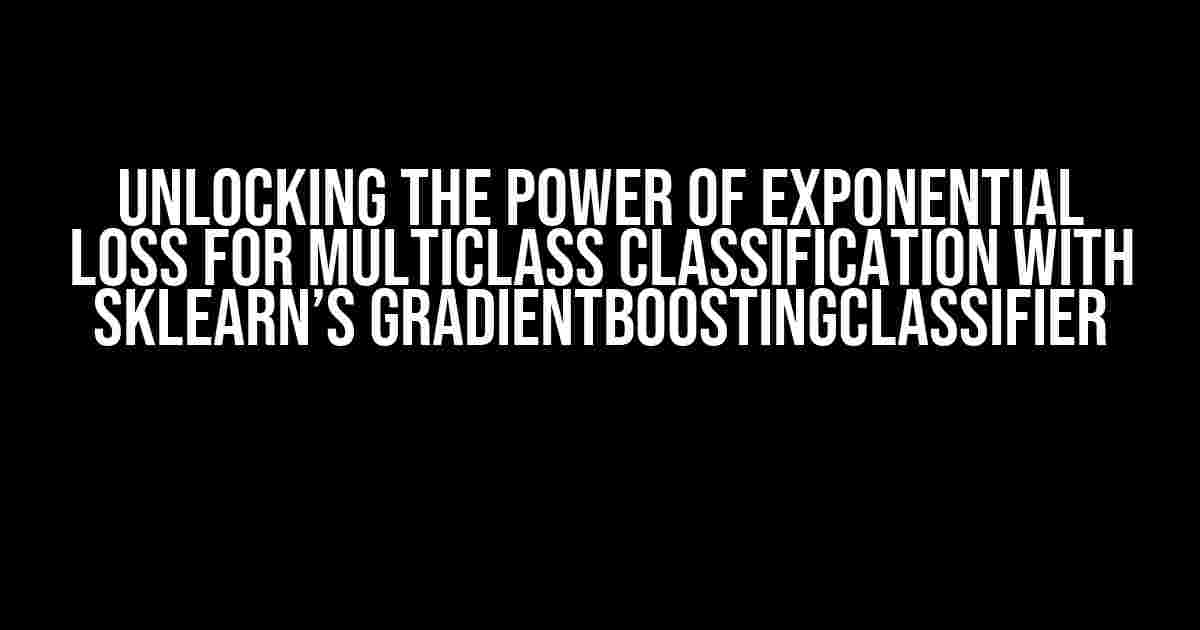When it comes to multiclass classification problems, choosing the right loss function is crucial for achieving accurate predictions. In this article, we’ll dive into the world of exponential loss and explore how it can be used with Sklearn’s GradientBoostingClassifier to improve the performance of your machine learning models.
What is Exponential Loss?
Exponential loss, also known as cross-entropy loss, is a popular loss function used in multiclass classification problems. It’s defined as the negative log likelihood of the true labels given the predicted probabilities. Mathematically, it can be represented as:
Exponential Loss = -∑(y_true * log(y_pred))where y_true is the true label and y_pred is the predicted probability.
Why Exponential Loss?
So, why do we need exponential loss? Here are a few reasons:
- Interpretability**: Exponential loss provides a clear interpretable result, making it easier to understand the performance of your model.
- Differentiability**: Exponential loss is differentiable, which makes it easy to optimize using gradient-based methods.
- Robustness**: Exponential loss is robust to outliers and noisy data, making it a great choice for real-world datasets.
Sklearn’s GradientBoostingClassifier
Sklearn’s GradientBoostingClassifier is a powerful algorithm for classification problems. It combines multiple weak models to create a strong predictive model. The algorithm works by iteratively training decision trees on the residuals of the previous tree, allowing it to capture complex interactions between features.
How to Use Exponential Loss with GradientBoostingClassifier
By default, Sklearn’s GradientBoostingClassifier uses the mean squared error (MSE) as the loss function. However, we can easily modify it to use exponential loss instead. Here’s an example:
from sklearn.ensemble import GradientBoostingClassifier
from sklearn.metrics import log_loss
# Define the GradientBoostingClassifier with exponential loss
gbc = GradientBoostingClassifier(loss='deviance')
# Train the model
gbc.fit(X_train, y_train)
# Evaluate the model using exponential loss
y_pred_proba = gbc.predict_proba(X_test)
exponential_loss = log_loss(y_test, y_pred_proba)
print('Exponential Loss:', exponential_loss)Tuning Hyperparameters for Best Results
To get the best results with exponential loss and GradientBoostingClassifier, it’s essential to tune the hyperparameters. Here are some tips:
- Learning Rate**: A lower learning rate can help improve the performance of the model, but it may increase the training time.
- n_estimators**: Increasing the number of estimators can improve the performance, but it may also increase the risk of overfitting.
- max_depth**: The maximum depth of the decision trees can affect the performance of the model. Increasing the depth can capture more complex interactions, but it may also increase the risk of overfitting.
Here’s an example of how to tune the hyperparameters using GridSearchCV:
from sklearn.model_selection import GridSearchCV
param_grid = {
'learning_rate': [0.01, 0.1, 1],
'n_estimators': [10, 50, 100],
'max_depth': [3, 5, 7]
}
grid_search = GridSearchCV(gbc, param_grid, cv=5, scoring='neg_log_loss')
grid_search.fit(X_train, y_train)
print('Best Parameters:', grid_search.best_params_)
print('Best Score:', grid_search.best_score_)Real-World Applications
Exponential loss and GradientBoostingClassifier can be applied to a wide range of real-world problems, including:
- Image Classification**: Classifying images into multiple categories, such as objects, scenes, and actions.
- Text Classification**: Classifying text into multiple categories, such as spam vs. non-spam emails or positive vs. negative reviews.
- Recommendation Systems**: Building recommendation systems that can predict user preferences for multiple items.
Conclusion
In this article, we’ve explored the power of exponential loss for multiclass classification problems using Sklearn’s GradientBoostingClassifier. By understanding how to use exponential loss and tune the hyperparameters, you can unlock the full potential of your machine learning models and achieve better results in real-world applications.
| Keyword | Description |
|---|---|
| Exponential Loss | A loss function used in multiclass classification problems, defined as the negative log likelihood of the true labels given the predicted probabilities. |
| GradientBoostingClassifier | A powerful algorithm for classification problems that combines multiple weak models to create a strong predictive model. |
| Sklearn | A popular machine learning library in Python that provides a wide range of algorithms and tools for building and evaluating machine learning models. |
By following the instructions and examples in this article, you’ll be well on your way to building accurate and robust machine learning models using exponential loss and GradientBoostingClassifier. Happy learning!
Frequently Asked Question
Get answers to your most pressing questions about exponential loss for multiclass classification with sklearn’s GradientBoostingClassifier!
What is exponential loss in multiclass classification?
Exponential loss, also known as cross-entropy loss, is a commonly used loss function in multiclass classification problems. It measures the difference between the predicted probabilities and the true labels of the samples. The goal is to minimize the exponential loss, which means maximizing the likelihood of correctly classifying the samples.
Why is exponential loss used in GradientBoostingClassifier?
GradientBoostingClassifier uses exponential loss because it is a suitable choice for multiclass classification problems. It is a differentiable function, which makes it easy to optimize using gradient-based methods. Additionally, exponential loss is sensitive to misclassifications, making it a good choice for boosting-based algorithms like GradientBoostingClassifier.
How does GradientBoostingClassifier implement exponential loss?
GradientBoostingClassifier implements exponential loss using the `deviance` loss function, which is a combination of the log loss and the exponential loss. The `deviance` loss function is used to measure the difference between the predicted probabilities and the true labels of the samples. The algorithm iteratively fits decision trees to the residuals of the previous iteration, using the `deviance` loss function to guide the optimization process.
Can I use other loss functions with GradientBoostingClassifier?
Yes, you can use other loss functions with GradientBoostingClassifier, such as the mean squared error (MSE) or the mean absolute error (MAE). However, these loss functions are typically used for regression problems, and may not be suitable for multiclass classification problems. If you want to use a different loss function for multiclass classification, you may need to implement it yourself or use a different algorithm.
How does the choice of loss function affect the performance of GradientBoostingClassifier?
The choice of loss function can significantly affect the performance of GradientBoostingClassifier. Different loss functions can lead to different optimization objectives, which can affect the accuracy and robustness of the model. For example, exponential loss is sensitive to misclassifications, which can lead to better performance on imbalanced datasets. On the other hand, MSE may be more robust to outliers, but can lead to suboptimal performance on multiclass classification problems.


